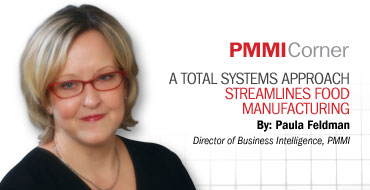
by Paula Feldman
To see this article in digital form, Click Here and see page 18.In 2008, the economic downturn knocked growth in the food processing industry down to two percent. Now, the market is expected to expand four to five percent annually over the next five years. But as food manufacturers ramp up production to meet this increasing demand, they will encounter specific hurdles-particularly in the areas of food safety, cost-efficiency and maximizing the potential of their facilities-they can overcome by bringing together their processing and packaging teams and streamlining operations.
Food processing and packaging often seem distinct, but they are unmistakably integrated. As certain segments of the processed food market grow, so will the use of packaging formats best suited for those foods. PMMI’s newest market study, Food Processing Machinery Market Assessment, indicates that 60% of respondents-a group that included food manufacturers and customers as well as machinery and materials suppliers-named frozen foods as the fastest-growing segment. Several respondents noted unexpected growth in canned foods, an anomaly stemming from the cost-effectiveness of this packaging type. However, according to the study, the most common packaging type in the U.S. food market overall is flexible packaging (32.3%), which lends itself to a wide variety of applications.
With an evolving packaging landscape, food processors will be challenged to transform or expand their manufacturing operations to accommodate the additional inventory and handle new product introductions. Streamlining machinery interactions is a necessary step in this transition. As a result, processing and packaging professionals need to communicate with each other, and understand the roles each part of the line plays in the manufacturing process. A mutual understanding of goals and pain points will foster more effective solutions to the big-picture challenges they face together.
The challenges
Food processors told PMMI researchers that food safety ranks as their most pressing issue. Provisions that are part of the Food Safety Modernization Act (FSMA) have shifted the regulatory environment from responsive to proactive, and as a result, brand owners and processing and packaging equipment suppliers are all paying closer attention to the risk of food contamination, even in the most hygienic facilities. Data collection and traceability technology, plus machinery designed for safe processing, cleaning and sanitation from the ground up, can help keep food safer, the report notes.
And then there’s the pressure to reduce costs. The challenging economy has prompted retailers to reduce stock of certain products to meet consumer demands for lower-priced goods. In response, survey respondents say that food processors are experimenting with their product offerings with costs in mind. They’re looking to introduce new products that are cost-efficient to make, while hitting as many high notes with consumers as possible.
The processing and packaging communities also share a need for customized equipment. According to the survey, 20–25% of equipment sold to food processors is made to order for specific facilities and customers. This level of customization allows food manufacturers to: increase efficiency; more easily adopt new materials, sizes and formats; ensure a smooth fit with existing equipment; accommodate proprietary processes; reduce carbon footprints; and introduce additional safety features.
Learn more about PMMI and the PACK EXPO trade shows atPMMI.organdPackexpo.com.
Paula Feldman, Director of Business Intelligence, PMMI